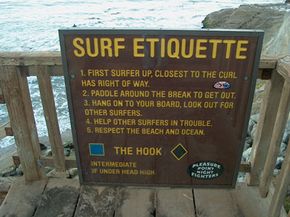Surfing Dangers
Tall, powerfulwavesthat break cleanly are at the heart of surfing. However, the qualities that make these waves alluring can also make them dangerous. Waves start to break when they reach water that's about 1.3 times their height. In other words, even if the wave seems to be far from shore, the water under it isn't very deep. In addition, since many waves break over coral reefs, the surface under the water can be sharp and jagged. Surfers whowipe out,或董事会脱落,可以有效ially hit submerged obstacles or the hard surface under the water.
The water itself can become a hazard as well. The water that reaches the shore must return to the sea, and in the right conditions, this retreating water can form arip current.A rip current is a fast-moving current moving toward the open sea. Swimmers who are caught in a rip current can be swept out further than they can swim back, or they can exhaust themselves fighting against the current. Most experts recommend swimming parallel to the shore to escape the pull of a rip current. SeeHow Rip Currents Workto learn more.
Advertisement
As surf areas become more crowded, surfers also have the potential to collide with each other. This is one of the reasons why responsible surfers follow acode of etiquettethat determines who has the right-of-way on a wave. Although these guidelines can vary from beach to beach, in general, the surfer closest to the wave's break has the right-of-way. If a surfer is already upright on a wave, he has priority over the other surfers.
Even if all of the surfers in an area are following guidelines for courteous riding, collisions are still possible. This is especially true if a surfer falls off of the board and loses it. In addition, surfers can collide with debris and trash floating in the water. This is one reason why surfers have started organizations like Surfers Against Sewage to fight for cleaner water.
Another common surfing hazard is the wildlife native to the ocean. Some people associateshark attackswith surfing, but these attacks are relatively rare. However, sharks do live near many popular surfing areas, and it's easy for a shark to mistake a paddling surfer for one of its food sources. Surfers can also encounterjellyfish, rays and other sea animals that can bite or sting.



